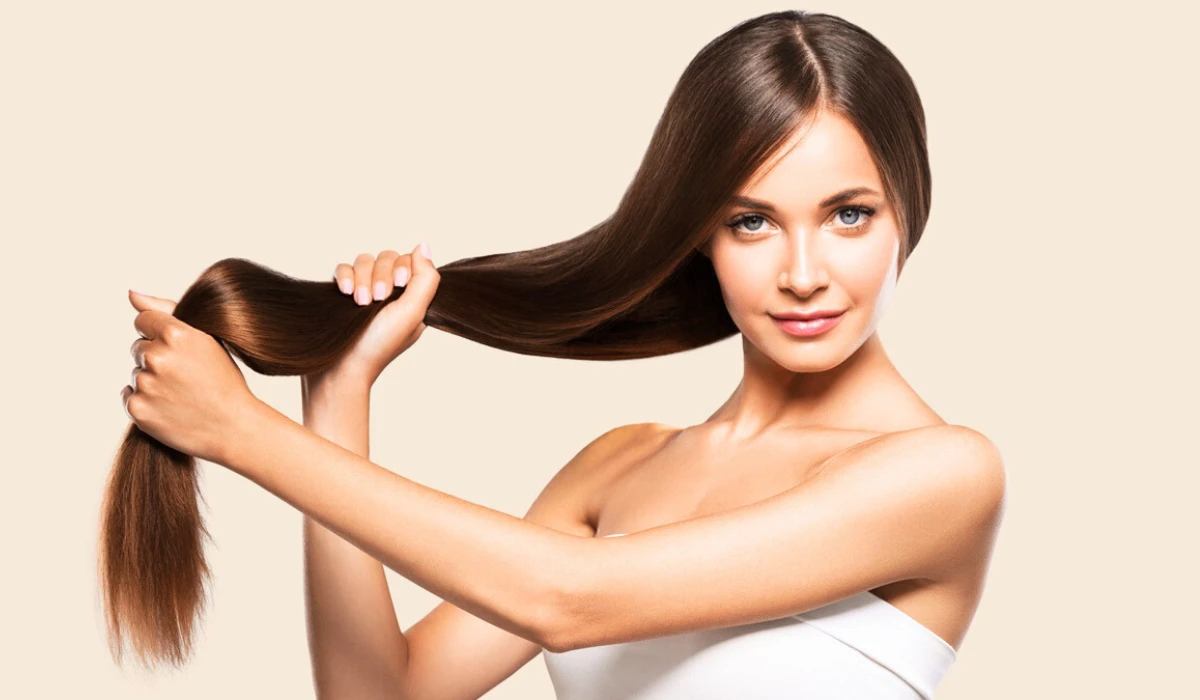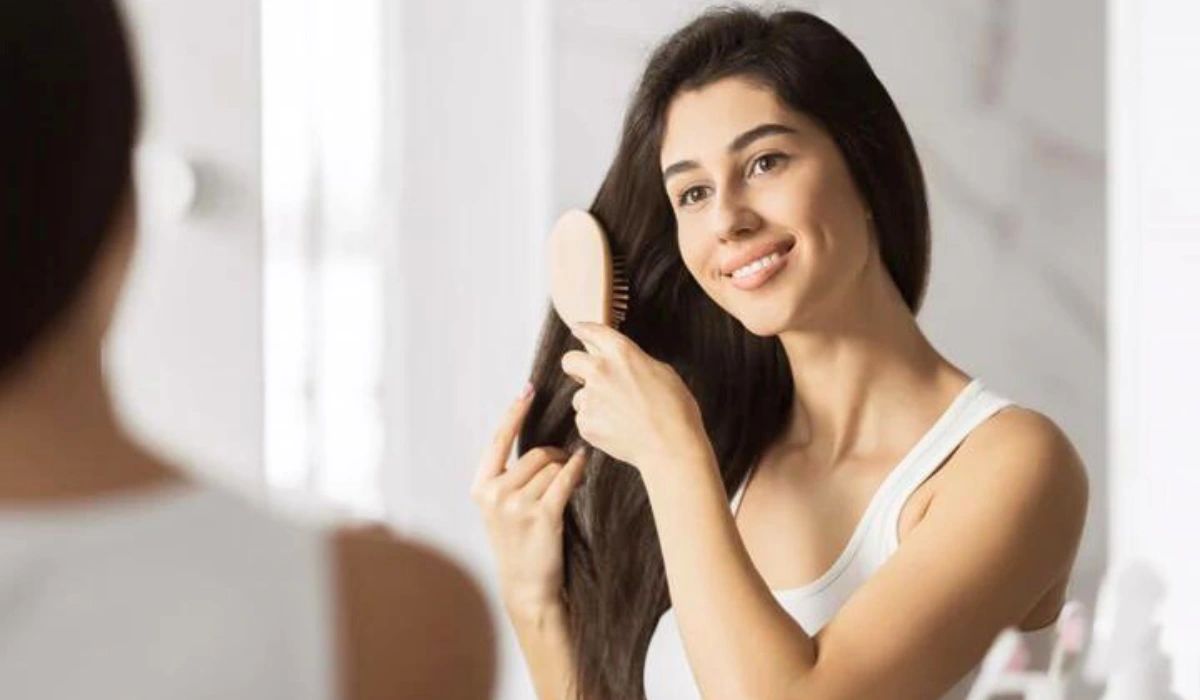When an individual is trying to lead a very healthy and proper lifestyle for the sake of hair health then he or she should also consider undergoing hair care routines. This journey is not simple. It includes an admixture of nutritional inputs and proper cleaning practices.
In this article, we will share with you in detail how to achieve this.
Understanding Your Hair Type

Knowing your hair type is essential for hair care. Your hair depends on its texture, straight, wavy, curly, or kinky. Each hair type requires particular care, starting with accepting its natural qualities, to optimize health and appearance. Smooth, smooth straight hair needs lightweight treatments to maintain its shine. Wavy hair benefits from hydrating products and less frizz. Creams moisturize and shape curls. Kinky hair needs intense moisture and nourishment to avoid dryness and damage. Knowing your hair type aids product and routine selection. Customizing your hair care routine to your hair type’s needs ensures optimal results.
Gentle Cleansing and Conditioning
Hair growth requires scalp hygiene. Try a sulfate-free shampoo that doesn’t deplete hair of its oils. Some shampoos contain harsh sulfates that deplete protective oils, drying and damaging. Clean gently with sulfate-free solutions to protect hair. Regular but not excessive washing is essential. Regular washing removes dirt, oil, and product residue, improving hair health. But over-cleaning might dry out hair. Clean scalps without dehydration demand equilibrium.
Scalp Massage and Stimulating Blood Flow
Anything that promotes hair development should include scalp massage. Scalp massage nourishes hair follicles and increases blood circulation. This easy but efficient treatment can revitalize hair. Massage your scalp in circles with your fingertips. Touch relaxes and enhances scalp blood flow. Hair follicles receive essential nutrients from better blood circulation, boosting development. Add natural oils to scalp massage for more benefits. Coconut and jojoba oils nourish and hydrate. Apply some of these oils to your palms before massaging your scalp. This enhances scalp hydration and massage. Coconut oil’s deep Moisturization protects hair from dryness. Jojoba oil, like scalp oils, nourishes hair well. Massage and natural oils nourish the scalp. Regular scalp massages renew and increase hair. A few minutes of this workout produces a healthy scalp and thick, vibrant hair.
Proper Nutrition for Healthy Hair
Hair care follows the “you are what you eat” philosophy. A diet rich in vitamins, minerals, and proteins encourages hair growth. Proper nutrition helps your hair grow and look its best. A diversified, nutrient-rich diet helps. Almonds, salmon, eggs, and leafy greens include hair-healthy vitamins and minerals. Eggs include biotin and other hair-growth elements, while salmon has omega-3 fatty acids. Proteins, antioxidants, and vitamins and minerals in nuts and leafy greens feed the scalp. Vitamins can assist, especially biotin with hair. B-vitamin biotin strengthens hair by synthesizing proteins. Take biotin tablets to grow hair. Hydration matters. To nourish your hair and scalp, drink enough water. Hydrating hair prevents dryness and makes it glossy.
Minimizing Heat and Chemical Damage
Overusing heat-styling tools and chemicals can damage and inhibit hair growth. Be careful with flat irons, curling wands, and hair dryers since high heat can damage hair. Use these styling tools sparingly to reduce harm. Keep hair safe when styling with heat. Choose heat protectants to protect your hair from extreme temperatures. These heat protection products keep hair healthy and prevent damage. Use hair coloring and chemicals cautiously. Chemicals weaken and impede hair development. Professionals are needed to minimize harm during these operations. Color and chemical treatments are accurate and safe for your hair professionals.
Regular Trimming for Healthy Ends
Hair health depends on regular trimming, refuting the notion that skipping cuts lengthens hair. Split ends break the hair shaft and stunt growth. To fix this, schedule cuts every 8-12 weeks. Split ends can harm hair once started. As they rise, they break hair, preventing growth. Trimming frequently prevents split ends and damage. By trimming your hair periodically, you remove damage and keep it clean. This technique repairs split ends and strengthens hair. It supports optimal hair development by strengthening and preventing breakage. Trim hair every 8-12 weeks to match growth. This interval prevents broken ends and encourages hair development. Regular trims renew and lengthen hair, disproving the misconception that avoiding trims lengthens it. It emphasizes balancing length preservation and hair health.
Protective Hairstyles and Night-time Care
Hair development and breakage prevention require protective hairstyles. Braids, twists, and buns lessen hair manipulation and external stress. This reduces damage and enhances hair health. Twists, braids, and buns prevent hair break. These styles keep your hair robust by reducing daily wear and tear. Choose these hairstyles to encourage hair growth and health. Protective patterns and satin or silk pillowcases to avoid friction and damage while you sleep. Cotton pillow friction tangles and destroys hair. Satin or silk pillows lessen friction, making night-time hair flow smoothly. A simple mattress change can protect your hair.
Patience and Consistency
Growing hair well needs time and consistency. Regular and comprehensive hair maintenance will improve outcomes. Avoid hair trends and stick to your hair type. Your regimen and healthy lifestyle unlock your hair’s potential. Developing hair is like developing a plant from seed. Be patient to observe results. Discovering and satisfying your hair type’s needs is holistic hair care. Choosing hair products and treatments carefully is important because what works for one may not work for another. This process requires consistency. You care about hair health by planning your hair care routine. As improvements occur gradually, your patience develops. Short cures and popular therapies may not last, so avoid them. Your hair care program works better with a healthy lifestyle. Healthy nutrition, hydration, and stress reduction improve hair health. Integrating internal and external maintenance keeps your locks healthy and robust. Healthy hair development requires patience, judgment, and consistency. Avoid trends, customize your routine, and balance exterior and interior care. Slow yet rewarding, your hair will attain its full potential thanks to your care.
Conclusion
Maintaining proper hair growth and hair health is not an easy task. The above-mentioned steps are the quintessential options to keep your buns intact, smooth, and flowing. The future of your beautiful lox depends a lot on it.
References:
- Robbins CR. Chemical and Physical Behavior of Human Hair. 5th ed. Berlin, Heidelberg: Springer Berlin Heidelberg; 2012. [Google Scholar]
- Velasco M VR, Dias TCdS, Freitas AZd. Hair fiber characteristics and methods to evaluate hair physical and mechanical properties. Braz J Pharm Sci. 2009;45(01):153–162. [Google Scholar]

